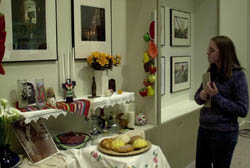Photographer captures celebration of life during days of the dead
Fireworks and parades may seem like an unusual way of remembering the death of a loved one in America, but in Mexico, it’s just another Day of the Dead.
Los Dias de los Muertos, or Days of the Dead, takes place every year November 1 and 2. During the first day all the children’s spirits are expected to return to their homes. The second is intended for the adult spirits.
Los Dias de los Muertos evolved through ancient Aztec traditions combined with the Christian holy days of All Saints Day and All Souls Day.
It is believed that this is the time when those who have passed away are allowed to return to Earth to visit their families and friends.
On Nov. 4, the Nora Eccles Harrison Museum of Art, held a special event commemorating the Days of the Dead.
The event was not only meant to inform visitors about the celebration but also give a unique perspective into the celebration through the photographs of Geoff Winningham’s, “In the Eye of the Sun, Mexican Fiestas” collection.
Winningham’s photographs which were taken over a period of 11 years show every aspect of the holiday from the perspectives of people from all walks of life.
“You can actually see and feel culture through the pictures,” said junior Jesse Mortensen a Spanish major.
The exhibit begins by introducing ofrendas which are altars arranged by families that hold food, flowers and pictures.
Ofrendas also include pictures of deceased family members and toys or drinks the family member liked.
Families then leave a path of marigolds from the ofrenda into the street to help the souls of the dead find their way back home.
“[The exhibit] was neat because they’re poor but still have altars,” said Mortensen.
One of the photographs on display was accompanied by a caption which read, “It is quite the reverse of morbid; it is a period full of life color and festival.”
Parades are also a big part of Day of the Dead. Much like skeleton costumes mock the dead, men may mock women by cross-dressing
“I liked the way they dress,” said Cajsa Montano, a senior majoring in math education. “I hadn’t seen all the costumes.”
People dress up as ghosts and skeletons, among other things and walk through the town.
Often, people will carry an open coffin filled with ofrendas for the dead which include flowers, fruits and candles.
The ofrendas also include a feast, which the spirits are said to enjoy before returning to the afterlife and fireworks are set off to attract the souls of the dead.
Late at night, armed with gardening tools, flowers, blankets, and picnic baskets, families go into the cemetery to clean and decorate graves; some families even spend the entire night in the graveyard.
“I didn’t realize the amount of time and effort spent. It’s also very family-oriented,” Mortensen said.
The most important symbol of the holiday is the calavera, or skull, which represents the playfulness of the dead, not the haunting of the soul.
Calaveras are incorporated in every aspect of the celebration. A special kind of bread call pan de muertos, or bread of dead, is also decorated with bones. Skeleton figures, called calacas, are used to portray an active and joyful afterlife.
Los Dias de Los Muertos is not a time of sadness. As the elders say, tears only wet the path of the dead and make it harder for them to return to the living.
Maria Luisa Spicer-Escalante, assistant professor of Spanish, was at the museum to help explain the traditions of Los Dias de Los Muertos.
Winningham’s photos were loaned to the museum by Rod Slemmons, director at the Museum of Contemporary Photography in Chicago. They were brought in part through a grant from the Marie Eccles Caine Foundation.
The exhibit, which took two days to set up and demanded the construction of four temporary walls, displays 56 photographs.
“The strength of the exhibit is that the photographs aren’t from one region, they’re from lots of cultural and religious backgrounds,” said Jay Heuman, the education curator for the museum. “It’s nice to be able to provide a glimpse into another religion’s traditions.”
“I think it’s awesome, I didn’t realize they change exhibits so much,” Mortensen said.
“We want to be thought-provoking. We incorporate what’s going on academically on campus,” said Heuman. “The role of the museum is the blending and fusion with other faculty members.
While the celebrations of the Days of the Dead honor and laugh at death, it also treats it as an everyday part of life – not something to be feared or hidden.
“In the Eyed of the Sun, Mexican Fiestas: Photographs” by Geoff Winningham will be on display through May 1, 2005.
-dpitcher@cc.usu.edu

